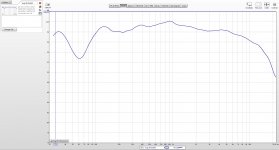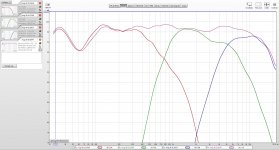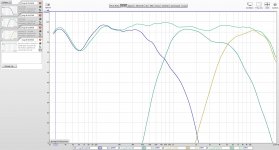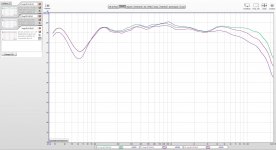After much much searching, I found some better specs on the 2215b I'm using.
Plugging some numbers into online calculators gives me;
Re 12 ohms (actual measured Re) Le 0.0022 H = zobel of 15 ohms and 15.277 uf
Same site for a 12 ohm, 12db, 700hz, Linkwitz-Riley = 5.45 mH and 9.5uF
Anyone care to comment on these findings ?
Manufacturer: JBL
Model: 2215b
Filename: 2215b.unt
Speaker type: Bass
Sd: 883.00 cm^2
Vas: 736.00 l
Cms: 4.07e-04 m/N
Cas: 3.27e-06 m^5/N
Mmd: 140.23 g
Mms: 97.00 g
Rms: 7.81 Ns/m
Fs: 20.0 Hz
Bl: 22.00 N/A
Re: 8.8 ohm ********
Le: 2.20 mH ********
Qms: 5.50
Qes: 0.22
Qts: 0.21
Pmax: 150.0 W
Xmax: 16.80 mm
The le is twice that of a le15a
Manufacturer: JBL
Model: 2215a same as LE15a
Filename: 2215a.unt
Speaker type: Bass
Sd: 883.00 cm^2
Vas: 736.00 l
Cms: 4.07e-04 m/N
Cas: 3.27e-06 m^5/N
Mmd: 140.23 g
Mms: 97.00 g
Rms: 7.81 Ns/m
Fs: 20.0 Hz
Bl: 17.46 N/A
Re: 5.50 ohm *******
Le: 1.00 mH *****
Qms: 5.50
Qes: 0.22
Qts: 0.21
Pmax: 150.0 W
Xmax: 16.80 mm
Plugging some numbers into online calculators gives me;
Re 12 ohms (actual measured Re) Le 0.0022 H = zobel of 15 ohms and 15.277 uf
Same site for a 12 ohm, 12db, 700hz, Linkwitz-Riley = 5.45 mH and 9.5uF
Anyone care to comment on these findings ?
Manufacturer: JBL
Model: 2215b
Filename: 2215b.unt
Speaker type: Bass
Sd: 883.00 cm^2
Vas: 736.00 l
Cms: 4.07e-04 m/N
Cas: 3.27e-06 m^5/N
Mmd: 140.23 g
Mms: 97.00 g
Rms: 7.81 Ns/m
Fs: 20.0 Hz
Bl: 22.00 N/A
Re: 8.8 ohm ********
Le: 2.20 mH ********
Qms: 5.50
Qes: 0.22
Qts: 0.21
Pmax: 150.0 W
Xmax: 16.80 mm
The le is twice that of a le15a
Manufacturer: JBL
Model: 2215a same as LE15a
Filename: 2215a.unt
Speaker type: Bass
Sd: 883.00 cm^2
Vas: 736.00 l
Cms: 4.07e-04 m/N
Cas: 3.27e-06 m^5/N
Mmd: 140.23 g
Mms: 97.00 g
Rms: 7.81 Ns/m
Fs: 20.0 Hz
Bl: 17.46 N/A
Re: 5.50 ohm *******
Le: 1.00 mH *****
Qms: 5.50
Qes: 0.22
Qts: 0.21
Pmax: 150.0 W
Xmax: 16.80 mm
Last edited:
Just that it seems to prove that everything I told you is exactly right.
It never was a Zobel on an 8 ohm driver. 10 ohms makes no sense since an 8ohm driver has a DCR nearer 6 ohms.
You'll notice that the opinionated experts (or Monkeys...) kinda disappear into the dust when it gets down to concrete suggestions.
I'd go for the simple 2:1 ratio over the original 8 ohm bass crossover.
What you do depends on what components you have lying round. Both setups will probably work well enough.
It never was a Zobel on an 8 ohm driver. 10 ohms makes no sense since an 8ohm driver has a DCR nearer 6 ohms.
You'll notice that the opinionated experts (or Monkeys...) kinda disappear into the dust when it gets down to concrete suggestions.
I'd go for the simple 2:1 ratio over the original 8 ohm bass crossover.
If I was going to guess, I'd say you double the coil and resistor in the bass section, and halve the capacitors, so that's 4.4mH, 20R and 10uF. That might be overdoing it a bit though. A 3.3mH coil and 15R and 12uF caps probably would be quite close too on a 3/2 ratio.
What you do depends on what components you have lying round. Both setups will probably work well enough.
Again, NO.
If I was ordering from scratch, I'd go for the 2:1 ratio.
Somehow I got the idea that you had a 3.3mH in your box, so I just did the best I could with that.
If I was ordering from scratch, I'd go for the 2:1 ratio.
If I was going to guess, I'd say you double the coil and resistor in the bass section, and halve the capacitors, so that's 4.4mH, 20R and 10uF. That might be overdoing it a bit though. A 3.3mH coil and 15R and 12uF caps probably would be quite close too on a 3/2 ratio.
Somehow I got the idea that you had a 3.3mH in your box, so I just did the best I could with that.
No slaps, you're cooking with gas now. 
Exact crossover values are kinda unpredictable with inexact data, but I think your researches are accurate.
4.4mh, 20R and 10uf looks entirely reasonable to me swapping an 8 ohm bass for a 16 ohm. If it doesn't work, well, no-one else has a better idea.
If it doesn't work, we'll probably try something else. It's actually quite fun. You know, that "Back to the Drawing Board" moment that anybody remotely creative sometimes faces.
Exact crossover values are kinda unpredictable with inexact data, but I think your researches are accurate.
4.4mh, 20R and 10uf looks entirely reasonable to me swapping an 8 ohm bass for a 16 ohm. If it doesn't work, well, no-one else has a better idea.
If it doesn't work, we'll probably try something else. It's actually quite fun. You know, that "Back to the Drawing Board" moment that anybody remotely creative sometimes faces.
I would like to thank you and everyone else for their input and help.
I've read through the sticky "Designing without measurement" several times.
So once I've got them running, I think I have a far better chance of achieving something pretty damn decent.
Recon this thread will die now for a few weeks.
I'll order the parts in the next few days, and I know some parts will have to come from o/s, so that'll slow me down a little, but then it'll be all ears to the grind stone
I promise I will return and update with the results..
I've read through the sticky "Designing without measurement" several times.
So once I've got them running, I think I have a far better chance of achieving something pretty damn decent.
Recon this thread will die now for a few weeks.
I'll order the parts in the next few days, and I know some parts will have to come from o/s, so that'll slow me down a little, but then it'll be all ears to the grind stone
I promise I will return and update with the results..
As promised, Update time.
The parts arrived, and have been 'thrown' into a (temporary) god awfull looking mess sitting atop some spare ply.
Initial thoughts.
More open, far cleaner, much better integration.
Bass is way more refined, probably due to the 100hz lower xover point as well as the change in the zobel.
The drivers just blend straight into each other.
I still need to play with mid and tweeter levels, not to mention port tuning.
I believe some of the improvement (cleaner, smoother sound) is due to using far better components than the previous version.
Might even drag the pc into the room and try for some measurements.
Hmm, full tower case, maybe, maybe not.
The parts arrived, and have been 'thrown' into a (temporary) god awfull looking mess sitting atop some spare ply.
Initial thoughts.
More open, far cleaner, much better integration.
Bass is way more refined, probably due to the 100hz lower xover point as well as the change in the zobel.
The drivers just blend straight into each other.
I still need to play with mid and tweeter levels, not to mention port tuning.
I believe some of the improvement (cleaner, smoother sound) is due to using far better components than the previous version.
Might even drag the pc into the room and try for some measurements.
Hmm, full tower case, maybe, maybe not.
After many months, finally got out the laptop, loaded REW, re-learnt just enough to do a few measurements, and played around for a few hours trying different things on the crossover.
These measurements are in room, mic at ear level, about 3.5 meters away.
Green is where I started the arvo.
Blue is with the tweeter disconnected.
Red is where I'm at after lowering the tweeter L pad.
Obviously the dip at 60hz is a room anomaly as it sure doesnt sound like theres a dip there.
Overall, sounds way better.
Tweeter and mid L pad resistors are just what I had lying around, so no where near the correct proportions in relation to each other.
I'm thinking, once I've got the L pads reset to better values, I'll set it back up, and do plots of each driver in turn.
See if I can't improve on this further...
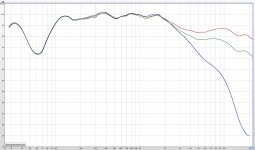
These measurements are in room, mic at ear level, about 3.5 meters away.
Green is where I started the arvo.
Blue is with the tweeter disconnected.
Red is where I'm at after lowering the tweeter L pad.
Obviously the dip at 60hz is a room anomaly as it sure doesnt sound like theres a dip there.
Overall, sounds way better.
Tweeter and mid L pad resistors are just what I had lying around, so no where near the correct proportions in relation to each other.
I'm thinking, once I've got the L pads reset to better values, I'll set it back up, and do plots of each driver in turn.
See if I can't improve on this further...

I think you've done really well here. That looks really good. 
Remind me, we just adjusted the original JBL crossover design for a change from 8 ohm bass to 16 ohms? Doubling inductance and resistance and halving capacitance in a 4 element bass filter. Then relying on the mid and treble level adjustment to balance it up.
Be nice to see a photo, even if the cabinet is a bit of a lash up currently. I don't know much about this sort of high efficiency speaker, but I guess it rocks the house!
Remind me, we just adjusted the original JBL crossover design for a change from 8 ohm bass to 16 ohms? Doubling inductance and resistance and halving capacitance in a 4 element bass filter. Then relying on the mid and treble level adjustment to balance it up.
Be nice to see a photo, even if the cabinet is a bit of a lash up currently. I don't know much about this sort of high efficiency speaker, but I guess it rocks the house!
Ta.
And yes, thats pretty well what I've done. (Followed your advise)
Started with Nelson Pass's new crossover with a change to the bass section.
His version (and all L300's) uses an 8ohm bass driver, where as these use a 16ohm.
So the series inductor is now 4.4mH, parallel cap is 10uF, and zobel of 10uf and 20 ohm.
Currently
Mid attenuator is ~7db
Tweeter is ~6db
Looking at the plot, I was wondering if I shouldn't raise the mid and tweeter levels further still.
still looks like a drop of ~4db over the bass at ~900 hz.
But I'm thinking I'll wait till I've got the proper value resistors in the L pad, do a remeasure, followed by some critical listening.
The vocal track on 'hotel california' was very recessed (green trace) until I did those measurements and raised the tweeter that ~3db (red trace)
Obligatory really crappy phone pic.
That tv is something like 48" to give perspective.
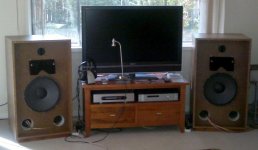
And yes, thats pretty well what I've done. (Followed your advise)
Started with Nelson Pass's new crossover with a change to the bass section.
His version (and all L300's) uses an 8ohm bass driver, where as these use a 16ohm.
So the series inductor is now 4.4mH, parallel cap is 10uF, and zobel of 10uf and 20 ohm.
Currently
Mid attenuator is ~7db
Tweeter is ~6db
Looking at the plot, I was wondering if I shouldn't raise the mid and tweeter levels further still.
still looks like a drop of ~4db over the bass at ~900 hz.
But I'm thinking I'll wait till I've got the proper value resistors in the L pad, do a remeasure, followed by some critical listening.
The vocal track on 'hotel california' was very recessed (green trace) until I did those measurements and raised the tweeter that ~3db (red trace)
Obligatory really crappy phone pic.
That tv is something like 48" to give perspective.

Those look very good!
"One of these nights" by the Eagles was my favourite listening test for 15" Tannoys in a big auditorium.
The Tannoy had a lot of adjustments available too.
I'd trust my ears on tweeter level here, but you do seem to have a bit of a BBC slope there above 2kHz. Perhaps more than you need. 2dB is actually quite a lot in power terms, about 60% increase IIRC.
I'm not sure I like the Nelson Pass first order tweeter filter much. It's a bit simplistic, isn't it? Can't be good for power handling.
"One of these nights" by the Eagles was my favourite listening test for 15" Tannoys in a big auditorium.
The Tannoy had a lot of adjustments available too.
I'd trust my ears on tweeter level here, but you do seem to have a bit of a BBC slope there above 2kHz. Perhaps more than you need. 2dB is actually quite a lot in power terms, about 60% increase IIRC.
I'm not sure I like the Nelson Pass first order tweeter filter much. It's a bit simplistic, isn't it? Can't be good for power handling.
It's straight varnished 22 mm 'flooring chipboard' (Red tounge). It's what he wanted. Primarily because when he grew up that was the best affordable option available so thats whats stuck in his mind as being 'best'.
Due to that I've included an internal brace that almost mirrors the front panel, half way between front and back panels.
I have the grills made (again his choice in color) so once the crossover is finalized and installed, I can mount the grills.
Now that will make a few eyes open
Yes, I agree it is a slope that you need to be careful with.
But, keeping in mind the tweeter has actually been tested (by others on 'Lansing heritage forum') as being between 10-12 ohm.
If you call it 12ohm, the 1uf gives a point of 13khz.
If you call it 10ohm, the 1uf gives 16khz.
That means it should be at worst ~ 12db down at 6khz, 18db at 3khz.
Now referring to jbl's info, the tweeter is rated to handle "40w continuous program above 6khz" (not quite sure how that relates to RMS, but lets assume 2/3 rating for RMS - say ~30w)
"105db/w/mtr"
I'm inclined to think it should be able to handle life reasonably well.
The old man, although deaf, only listens to classical (yes a fair bit of violin lately), and hes never had them to a point where conversation is difficult.
Just found a post that suggests violins stop at ~10k, but thats only harmonics of the true 4.5khz top end of the violin.
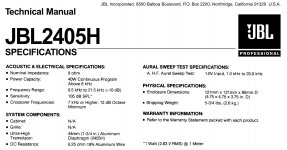
Due to that I've included an internal brace that almost mirrors the front panel, half way between front and back panels.
I have the grills made (again his choice in color) so once the crossover is finalized and installed, I can mount the grills.
Now that will make a few eyes open
Yes, I agree it is a slope that you need to be careful with.
But, keeping in mind the tweeter has actually been tested (by others on 'Lansing heritage forum') as being between 10-12 ohm.
If you call it 12ohm, the 1uf gives a point of 13khz.
If you call it 10ohm, the 1uf gives 16khz.
That means it should be at worst ~ 12db down at 6khz, 18db at 3khz.
Now referring to jbl's info, the tweeter is rated to handle "40w continuous program above 6khz" (not quite sure how that relates to RMS, but lets assume 2/3 rating for RMS - say ~30w)
"105db/w/mtr"
I'm inclined to think it should be able to handle life reasonably well.
The old man, although deaf, only listens to classical (yes a fair bit of violin lately), and hes never had them to a point where conversation is difficult.
Just found a post that suggests violins stop at ~10k, but thats only harmonics of the true 4.5khz top end of the violin.

Last edited:
And todays update.
Replaced the rats nest of mixed resistors for mid and tweeter L pads.
Did some new measurements.
First graph. - New resistors of proper value proportions.
Obviously still rather low in treble (12p + 5.1s ohm L pad)
Second graph. - Raised tweeter output further (22p +3.9s ohm L pad). Also did Individual graphs.
Hmm, lets go further.
Third graph. - Yet mwoar Tweeter (22p + 0s ohm L pad). Still individual graphs.
That looks better.
Must admit, I'm suprised at how far I've had to raise the tweeter.
Also suprised at the individual response curves.
These are taken WITH the xover in place. At a distance of about 3 meters.
I'm guessing (hoping) the room reflections etc are whats causing the big dips here and there.
As always, very happy to hear others opinions.
Now to leave it be and do some listening........
I suspect I might end up with the 22p + 3.9s combo.
EDIT, and one last graph that compares the three tweeter changes to make it easier to see what the difference is.........
Replaced the rats nest of mixed resistors for mid and tweeter L pads.
Did some new measurements.
First graph. - New resistors of proper value proportions.
Obviously still rather low in treble (12p + 5.1s ohm L pad)
Second graph. - Raised tweeter output further (22p +3.9s ohm L pad). Also did Individual graphs.
Hmm, lets go further.
Third graph. - Yet mwoar Tweeter (22p + 0s ohm L pad). Still individual graphs.
That looks better.
Must admit, I'm suprised at how far I've had to raise the tweeter.
Also suprised at the individual response curves.
These are taken WITH the xover in place. At a distance of about 3 meters.
I'm guessing (hoping) the room reflections etc are whats causing the big dips here and there.
As always, very happy to hear others opinions.
Now to leave it be and do some listening........
I suspect I might end up with the 22p + 3.9s combo.
EDIT, and one last graph that compares the three tweeter changes to make it easier to see what the difference is.........
Attachments
Last edited:
- Status
- This old topic is closed. If you want to reopen this topic, contact a moderator using the "Report Post" button.
- Home
- Loudspeakers
- Multi-Way
- Help me understand this crossover.
